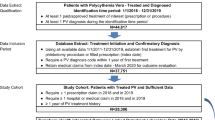Summary
Epidemiology of polycythemia vera (PV) is derived from cohort studies in Western populations. PV studies in the Latin population are limited and have described a lower prevalence of JAK2 mutation. A retrospective cohort of 90 Mexican patients from a single center with PV according to the 2016 World Health Organization diagnostic criteria was studied to establish clinical presentation in Mexicans and evaluate risk factors for mortality and vascular events. At diagnosis, the median age was 59 years; half were females, 90.7% harbored the JAK2 V617F mutation, and 7.1% had an exon 12 mutation. Arterial and venous thromboses were observed in 13.3 and 27.8% of patients, respectively. Seventy-one patients received hydroxyurea and one interferon alpha-2a, of which 51.5% achieved a complete response and 25.0% a partial response. The incidence rate for postdiagnosis arterial thrombosis was 2.68 cases per 100 person–years, for venous thrombosis 2.84, for major hemorrhage 2.57, for progression to myelofibrosis 1.14, and for leukemic transformation 0.44. The mortality rate was 3.54 cases per 100 person–years, and median of survival was 150 months. In multivariable analysis, survival was adversely affected by leukocytosis ≥12 × 109/L (p = 0.013); thrombocytosis ≥450 × 109/L was a risk factor for arterial thrombosis (p = 0.023), and anticoagulation at diagnosis for major hemorrhage (p = 0.049). In conclusion, epidemiology of PV in Mexican population is similar to that reported in Western studies, but with more venous thrombosis at diagnosis and a higher incidence of vascular complications postdiagnosis.



Similar content being viewed by others
References
Ayalew Tefferi TB. Polycythemia vera and essential thrombocythemia: 2019 update on diagnosis, risk-stratification, and management. Am J Hematol. 2019;94:133–43.
Barbui T, Thiele J, Vannucchi AM, Tefferi A. Rationale for revision and proposed changes of the WHO diagnostic criteria for polycythemia vera, essential thrombocythemia, and primary myelofibrosis. Blood Cancer J. 2015;5:e337–e8. https://doi.org/10.1038/bcj.2015.64.
Tefferi A, Rumi E, Finazzi G, et al. Survival and prognosis among 1545 patients with contemporary polycythemia vera: an international study. Leukemia. 2013;27:1874–81. https://doi.org/10.1038/leu.2013.163.
Passamonti F, Rumi E, Pietra D, et al. A prospective study of 338 patients with polycythemia vera: the impact of JAK2 (V617F) allele burden and leukocytosis on fibrotic or leukemic disease transformation and vascular complications. Leukemia. 2010;24:1574–9. https://doi.org/10.1038/leu.2010.148.
Finazzi G, Barbui T. Evidence and expertise in the management of polycythemia vera and essential thrombocythemia. Leukemia. 2008;22:1494–502. https://doi.org/10.1038/leu.2008.177.
Tefferi A. Polycythemia vera and essential thrombocythemia: 2013 update on diagnosis, risk-stratification, and management. Am J Hematol. 2013;88:508–16. https://doi.org/10.1002/ajh.23417.
Bonicelli G, Abdulkarim K, Mounier M, et al. Leucocytosis and thrombosis at diagnosis are associated with poor survival in polycythemia vera: A population-based study of 327 patients. Br J Haematol. 2013;160:251–4. https://doi.org/10.1111/bjh.12117.
Tefferi A, Vannucchi AM, Barbui T. Polycythemia vera treatment algorithm 2018. Blood Cancer J. 2018; https://doi.org/10.1038/s41408-017-0042-7.
Marchioli R, Finazzi G, Specchia G, et al. Cardiovascular events and intensity of treatment in polycythemia vera. N Engl J Med. 2013;368:22–33. https://doi.org/10.1056/NEJMoa1208500.
Landolfi R, Marchioli R, Kutti J, et al. Efficacy and safety of low-dose aspirin in polycythemia vera. N Engl J Med. 2004;350:114–24. https://doi.org/10.1056/NEJMoa035572.
Ruiz-Argüelles GJ, López-Martínez B, Lobato-Mendizábal E, Ruiz-Delgado GJ. In addition to geographic hematology: chronic myeloproliferative diseases are infrequent in Mexican mestizos. Int J Hematol. 2002;75:499–502. https://doi.org/10.1007/BF02982113.
Labastida-Mercado N, Galindo-Becerra S, Garcés-Eisele J, et al. The mutation profile of JAK2, MPL, and CALR in Mexican patients with Philadelphia chromosome-negative myeloproliferative neoplasms. Hematol Oncol Stem Cell Ther. 2015;8:16–21. https://doi.org/10.1016/j.hemonc.2014.12.002.
Ruiz-Argüelles GJ, Garcés-Eisele J, Reyes-Núñez V, et al. The Janus Kinase 2 (JAK2) V617F mutation in hematological malignancies in México. Rev Invest Clin. 2006;58:458–61.
Barosi G, Mesa R, Thiele J, et al. Proposed criteria for the diagnosis of post-polycythemia vera and post-essential thrombocythemia myelofibrosis: a consensus statement from the international working group for myelofibrosis research and treatment. Leukemia. 2008;22:437–8. https://doi.org/10.1038/sj.leu.2404914.
Arber DA, Orazi A, Hasserjian R, et al. The 2016 revision to the World Health Organization classification of myeloid neoplasms and acute leukemia. Blood. 2016;127:2391–406. https://doi.org/10.1182/blood-2016-03-643544.
Barosi G, Birgegard G, Finazzi G, et al. Response criteria for essential thrombocythemia and polycythemia vera: result of a European LeukemiaNet consensus conference. Blood. 2009;113:4829–33. https://doi.org/10.1182/blood-2008-09-176818.
Barosi G, Birgegard G, Finazzi G. A unified definition of clinical resistance and intolerance to hydroxycarbamide in polycythemia vera and primary myelofibrosis: results of a European LeukemiaNet (ELN) consensus process. Br J Haematol. 2010;148:948–63. https://doi.org/10.1111/j.1365-2141.2009.08019.x.
Valla D, Casadevall N, Lacombe C, et al. Primary myeloproliferative disorder and hepatic vein thrombosis. A prospective study of erythroid colony formation in vitro in 20 patients with Budd-Chiari syndrome. Ann Intern Med. 1985;103(3):329-34. https://doi.org/10.7326/0003-4819-103-3-329.
Patel RK, Lea NC, Heneghan MA, et al. Prevalence of the activating JAK2 tyrosine kinase mutation V617F in the Budd-Chiari syndrome. Gastroenterology. 2006;130:2031–8. https://doi.org/10.1053/j.gastro.2006.04.008.
Thurmes PJ, Steensma DP. Elevated serum erythropoietin levels in patients with Budd-Chiari syndrome secondary to polycythemia vera: clinical implications for the role of JAK2 mutation analysis. Eur J Haematol. 2006;77:57–60. https://doi.org/10.1111/j.1600-0609.2006.00667.x.
Levy VG, Ruskone A, Baillou C, et al. Polycythemia and the Budd-Chiari syndrome: study of serum erythropoietin and bone marrow erythroid progenitors. Hepatology. 1985;5:858–61. https://doi.org/10.1002/hep.1840050525.
Acknowledgements
The authors thank the Laboratory of Hematology and the Laboratory of Pathology for running JAK2 mutations tests and quantifying allele burden when necessary.
Author information
Authors and Affiliations
Contributions
A. Olivas-Martinez conceived and designed the study, performed data analysis, contributed to results interpretation and wrote the paper. E.J. Tuna-Aguilar contributed to design of the study, results interpretation, manuscript preparation, and drafted the manuscript. O. Barrales-Benítez, D. Aguilar-León and H.E Hernández-Juárez performed JAK2 mutation tests and contributed to interpretation of the results. D. Montante-Montes-de-Oca reviewed bone marrow biopsies and contributed to results interpretation.
Corresponding author
Ethics declarations
Conflict of interest
A. Olivas-Martinez, O. Barrales-Benítez, D. Montante-Montes-de-Oca, D. Aguilar-León, H.E. Hernández-Juárez, and E. Tuna-Aguilar declare that they have no competing interests.
Additional information
Publisher’s Note
Springer Nature remains neutral with regard to jurisdictional claims in published maps and institutional affiliations.
Rights and permissions
About this article
Cite this article
Olivas-Martinez, A., Barrales-Benítez, O., Montante-Montes-de-Oca, D. et al. Epidemiology of polycythemia vera in a Mexican population. memo 13, 111–117 (2020). https://doi.org/10.1007/s12254-019-00537-4
Received:
Accepted:
Published:
Issue Date:
DOI: https://doi.org/10.1007/s12254-019-00537-4




